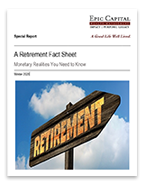How To Rollover Your 401(k)?
May 29, 2024

When leaving your job or retiring, you have several options available for managing your retirement plan assets. You may be able to leave the money in your current plan, if your employer allows. Or you can take a lump-sum cash distribution, which will be subject to income tax and a 10% penalty if you’re under age 59½ (unless an exception applies), resulting in a potentially significant tax bill. Finally, you can roll the money into another tax-deferred account, preserving the primary tax advantages.
There are two types of rollovers: direct and indirect. A direct rollover, or trustee-to-trustee transfer, is paid from your plan directly to your IRA or to your new employer’s retirement plan. The funds are never payable to you. An indirect (60-day) rollover is a payment made to you that you later roll over to an IRA or an employer retirement plan.1 When you request a distribution from your employer’s 401(k), 403(b), or governmental 457(b) plan that’s eligible for rollover, you’ll receive a statement describing the tax rules applicable to your distribution and your rollover options.2 You should read that statement carefully.
1. Direct rollover to a new employer’s plan:
- Review your existing plan’s distribution form for instructions on completing a direct rollover to another employer retirement plan.
- Contact the new plan’s administrator and ask what it requires to accept a rollover.
- Your plan administrator will either transfer the funds directly to your new plan via check or wire transfer, or provide you with a check (payable to your new plan) to deposit into your account.
2. Direct rollover to an IRA:
- Review your existing plan’s distribution form for instructions on completing a direct rollover to an IRA.
- You can use an existing IRA account or set up a new IRA account at the financial institution of your choice to accept the rollover.3
- Provide your IRA account number and other information to your plan administrator.
- Your plan administrator will either transfer the funds directly to your IRA via check or wire transfer, or provide you with a check (payable to your IRA) to deposit into your account.
- Contact your financial institution for assistance (most have rollover specialists who can guide you through the process).
3. Indirect (60-day) rollover:
- Have your plan administrator make the distribution to you.
- The plan administrator will either issue a check in your name or make a wire transfer to your bank account.
- If you are making an indirect rollover to an IRA, you can use an existing IRA account or set up a new IRA account at the financial institution of your choice to accept the rollover.3
- If you are making an indirect rollover to a new employer’s plan contact the plan administrator and ask what it requires to accept a rollover.
- Roll all or part of the funds over by the 60th day after the day you receive the distribution from your plan.4
Before making any decisions, be sure to consider the potential advantages and disadvantages of the types of accounts you are considering. For example, while IRAs may offer a wider variety of investments to choose from, the cost structure for the investments offered in a retirement plan may be more favorable than those offered in an IRA.
This information is not intended as tax, legal, investment, or retirement advice or recommendations.
For more insights and resources, be sure to sign up for our Weekly Market Commentary. Follow our YouTube channel where we regularly post our Epic Market Minute videos. Follow us on LinkedIn, or like us on Facebook. And as always, please don’t hesitate to reach out to a dedicated service professional at Epic Capital.
1There are two major disadvantages to indirect rollovers. First, your plan is required to withhold 20% of the taxable portion of your payment for federal income taxes. You'll get credit for that amount when you file your federal income tax return, but if you want to roll over the entire distribution, you'll have to come up with the 20% that was withheld from other sources. Second, you run the risk of missing the 60-day deadline, which would make your distribution taxable. On the plus side, you'll have use of the funds for up to 60 days. In general, direct rollovers are the safer choice. 2You cannot roll over hardship withdrawals, required minimum distributions, substantially equal periodic payments, corrective distributions, and certain other payments. Nonspousal death benefits can be rolled over only to an inherited IRA, and only in a direct rollover or trustee-to-trustee transfer. You may have the option of leaving your funds in your employer's plan — consult your plan's terms. 3You do not need to set up a special "Rollover IRA" account (sometimes called a "conduit IRA") to receive your rollover, although some financial firms may require that you do so at least initially. (You can always transfer the funds to a different IRA account later.) While not required, in some cases a separate rollover IRA may be helpful if: (a) you think you may want to roll the taxable portion of your distribution back to an employer plan at some future date, or (b) you're concerned about protection from creditors, as funds rolled over from an employer plan (and any earnings on those funds) generally receive unlimited protection under federal law if you declare bankruptcy. 4The IRS may waive the 60-day requirement where the failure to do so would be against equity or good conscience, such as in the event of a casualty, disaster, or other event beyond your reasonable control. There are three ways to obtain a waiver of the 60-day rollover requirement: (a) you qualify for an automatic waiver, (b) you self-certify that you met the requirements of a waiver, or (c) you request and receive a private letter ruling granting a waiver. Consult a tax professional. Note: If you receive employer stock or other securities as part of your distribution be sure to understand the tax consequences before making a rollover to an IRA. Your distribution may be entitled to favorable net unrealized appreciation (NUA) tax rules. Consult a tax professional.
Tags: Certified Financial Advisor Charlotte NC, Certified Financial Planner Charlotte NC, financial advisor charlotte nc, Financial Help, Financial Planning, retirement, Retirement Planning, Wealth Building
More Insights
April showers came a month early as stocks fell in March. Tariffs were the primary cause of the market jitters, although that uncertainty became too much for markets to shrug off once economic data started to weaken.
A successful investor maximizes gain and minimizes loss. Though there can be no guarantee that any investment strategy will be successful and all investing involves risk, including the possible loss of principal, here are six basic principles that may help you invest more successfully.
Losing a spouse is a stressful transition. And the added pressure of having to settle the estate and organize finances can be overwhelming. Fortunately, there are steps you can take to make dealing with these matters less difficult.
Families are one of the great joys in life, and part of the love you show to your family is making sure that their basic needs are met. While that’s only to be expected from birth through the high school years, many households are helping their adult children well into their twenties and beyond at … Continue reading “Retirement and Adult Children”
Life insurance can be an excellent tool for charitable giving. Not only does life insurance allow you to make a substantial gift to charity at relatively little cost to you, but you may also benefit from tax rules that apply to gifts of life insurance.
Services
Epic Capital provides the following comprehensive financial planning and investment management services: Learn More >


 Top of Page
Top of Page











